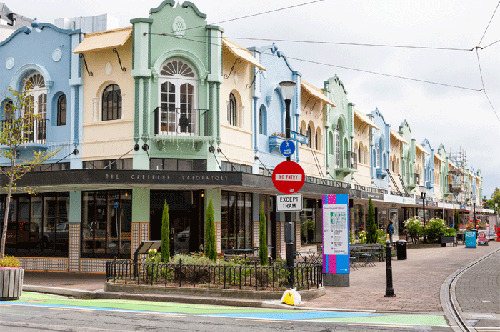Rebuilding better neighbourhoods
New Regent Street in Christchurch now draws locals and tourists. Credit: Opus Research.
As part of the National Science Challenge spearheaded by BRANZ, Building Better Homes, Towns and Cities, several IRANZ members have recently published research to help make our living environments a better place.
In the wake of the devastating
The survey research, led by Opus Research’s Dr Vivienne Ivory, showed that, while potential residents will accept some trade-offs while the city is rebuilt, living well was the top consideration. “Inner-city dwellers are generally more interested in restaurants, cinemas or other entertainment than suburban dwellers. However, what counts as a good place to live still includes quality housing, supermarkets, healthcare and open spaces – the same as for those living in suburbs. Another important message for the rebuilders is that potential residents will want many of their everyday needs met in the local urban setting. Accordingly, their living environment would be based more on walking than that in a typical suburban lifestyle,” says Dr Ivory.
Dr Ivory say it is important that there is adequate support for a reasonable quality of life for residents during the rebuild, not just once the rebuild is complete, if the city hopes to achieve a vibrant central city long term.
“For example, if the central city is made safe and walkable throughout the rebuild construction, this sends a message to potential and current residents that their needs are prioritised. It says that they can expect to live an urban lifestyle rather than drive everywhere as in the suburbs. Similarly, encouraging relatively low-return developments such as food retailers and public open spaces to support central city residents may also be vital to establish the core liveability services and qualities [survey] participants identified.
“If you build high-quality housing and services in the central city, people will want to live there and central city businesses will have a local market. Acknowledging and planning for the interdependency of residents, infrastructure, developers and businesses is critical for a successful central city.”
Valuing sunshine
The famous Swiss-born French architect Le Corbusier once said that people needed space and light just as much as they need bread or a place to sleep. To paraphrase, dwellings that are situated or designed with good exposure to sunlight are generally preferred as places to live and work compared to those with lesser light levels. Now, research organisation Motu Economic and Public Policy Research have managed to put a price on that sunshine. According to the Building Better Homes, Towns and Cities challenge study, involving data from over 5000
Paper co-author Prof. Arthur Grimes, a Senior Fellow at Motu Economic and Public Policy Research, was interviewed earlier this month by Radio New
For more information about the Opus Research rebuild survey please see http://www.buildingbetter.nz/news/case_studies.
For more information about the Motu study Valuing Sunshine please see http://motu.nz/our-work/urban-and-regional/housing/valuing-sunshine/ and http://www.buildingbetter.nz/news/case_studies. For a copy of the full report, please download http://motu-www.motu.org.nz/wpapers/17_13.pdf.
To listen to Arthur Grimes Giving sunshine a price tag interview on Radio New Zealand's, Nine to Noon programme, with Kathryn Ryan, please click play below:
Date posted: 22 July 2017

